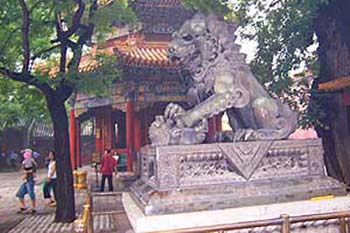
Riding along between the sounds of squeaking wheels, honking horns, ringing bells, and shouts of hello
By Nicholas Hogg

Beijing is huge, especially if the bike you’ve rented is as heavy as a lump of solid iron, and the air you’re breathing is thick with fumes belched from diesel guzzling trucks and beaten up taxis.
Yet this is the way to get around in China’s teeming capital. Forget sitting in a Beijing traffic jam with the meter ticking over, or dueling elbows on the overcrowded buses, pedal power is the choice of a nation and any tourist ready to forget their rights of way and highway code.
Clunking through the only two available gears, I set off from my hotel in the Sanlitun district and headed for the general direction of Tiananmen Square. Although the rush-hour throng had thinned out a little, it was still a swirling mass of bikes, buses, and trucks jostling for every inch of road available.
Luckily, the first avenue I had chosen to rediscover my cycle courier skills on had a separate bike-only lane, with just the occasional speeding taxi zipping through like a getaway car.
Sound of Squeaking Wheels
The pace varied from tiny old men on three-wheeled jalopies to racing schoolboys weaving through the smallest gaps. I rode along between the sounds of squeaking wheels, honking horns, ringing bells, and shouts of hello, not really having time to take in the pulsing street life around me, but thrilled to be in the flurry of a Beijing commute.
I soon found out that red lights were more advice than command, and that crossing at intersections was best done in the safety of numbers – scarily similar to the way a herd of wildebeest charge a flooded river before they become crocodile food.
Just as I was about to check my map again, the road in front opened up onto the vast concrete space of Tiananmen Square. Few people will forget the heroic defiance of the lone protestor who stood before the rumbling tanks during the 1989 demonstrations, and it was this image that came to mind first as I rode into the summer glare of Beijing’s historical and infamous landmark.
Red Guard
Although it is a busy tourist spot for both Chinese and foreign visitors, the presence of the Red Guard is not just for photo opportunities. On my arrival, a small group of protesters attempted to stop the traffic by unfurling a banner across the road. Statuesque sentries sprung into action and dragged them like rag dolls into vans that vanished as quickly as they had appeared.
Only a few weeks before my arrival, some Australian members of the banned spiritual movement, Falun Gong, were arrested during a peaceful sit-down demonstration. Needless to say, I had no problem obeying the command of a young guard when asked to dismount my bike and walk.
All this was watched by the ubiquitous face of chairman Mao, looming above the scene from the framing gates of the Forbidden City. The giant mural looks out over the square, providing the perfect backdrop for any tourist photos. As I took my camera out of my bag, a young Chinese boy no older than three or four stood stern-faced and proud, every part the patriot, as his parents snapped away.
After strolling the spacious courtyards, palaces and gardens of the Forbidden City, where twenty-four emperors of the Ming and Qing dynasties had ruled from for almost five centuries, I turned off the headset commentary by none other than 007 himself, Roger Moore, and left the beautiful russet walls to stand in line to see a corpse.
Glimpse of Mao
Hundreds wait for the glimpse of a waxen Mao laid out in a glass case. The bizarre event of filing past a dead dictator is, of course, concluded with a wander around the Chairman’s shop of tacky souvenirs and piling up a basket with Mao watches, pens, mugs, and cigarette lighters.
Escaping the traffic and summer heat, like the Imperial family had been doing for centuries before, I rode over to the lake and gardens of the Beihai Gongyuan, resting my saddle sore rear in a shady spot by the white Tibetan pagoda that looks out over the park from a small hill.
A few ice creams and a paddle boat later, with the late afternoon sun a little less fierce, I wheeled through the old neighborhoods of Hutongs to find markets, mahjong players, and other symbols of more traditional Chinese street life amongst the crumbling, back to back, one-story brick houses.
Despite the construction of towering hotels and gleaming department stores, globalization and a Beijing booming with capitalism and preparations for the 2008 Olympics, a bike ride through the dusk lit back streets was journey to a time when the world moved a little more slowly, and the greatest highway danger to a cycling tourist was a collision with a chicken.
Contact the author at nicholasahogg@yahoo.com
- These 9 U.S. National Parks Require Reservations in 2024 - April 17, 2024
- Take a Hike in Olympic National Park - April 17, 2024
- The Wild Mississippi: 2340 Miles Across Ten States - April 8, 2024

